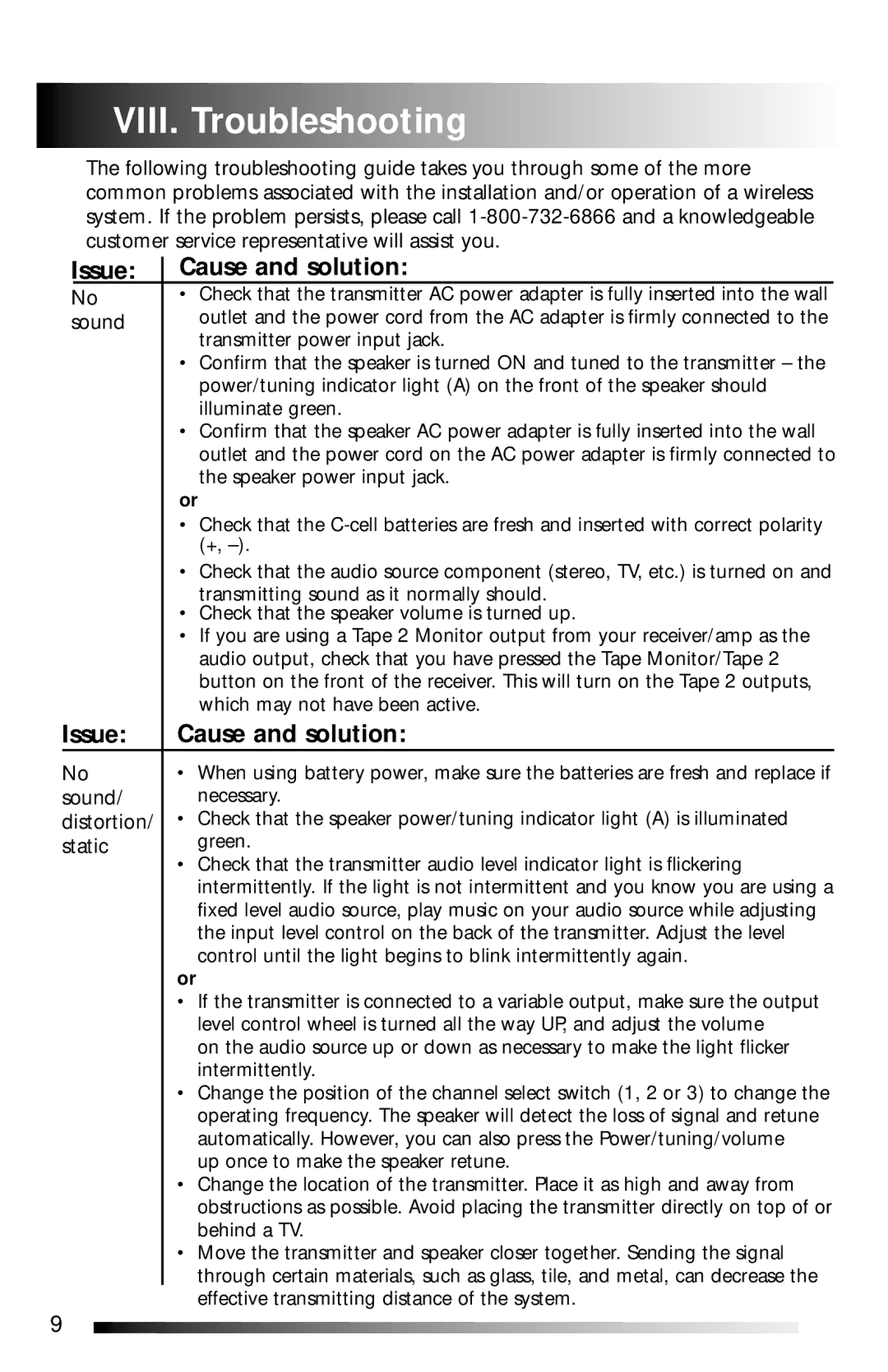












 VIII.
VIII.


 Troubleshooting
Troubleshooting





























































The following troubleshooting guide takes you through some of the more common problems associated with the installation and/or operation of a wireless system. If the problem persists, please call
| Issue: | Cause and solution: | ||
| No | • | Check that the transmitter AC power adapter is fully inserted into the wall |
|
| sound |
| outlet and the power cord from the AC adapter is firmly connected to the | |
|
|
| transmitter power input jack. | |
|
| • | Confirm that the speaker is turned ON and tuned to the transmitter – the | |
|
|
| power/tuning indicator light (A) on the front of the speaker should | |
|
|
| illuminate green. | |
|
| • | Confirm that the speaker AC power adapter is fully inserted into the wall | |
|
|
| outlet and the power cord on the AC power adapter is firmly connected to | |
|
|
| the speaker power input jack. | |
|
| or | ||
|
| • | Check that the | |
|
|
| (+, | |
|
| • | Check that the audio source component (stereo, TV, etc.) is turned on and | |
|
|
| transmitting sound as it normally should. | |
|
| • | Check that the speaker volume is turned up. | |
|
| • | If you are using a Tape 2 Monitor output from your receiver/amp as the | |
|
|
| audio output, check that you have pressed the Tape Monitor/Tape 2 | |
|
|
| button on the front of the receiver. This will turn on the Tape 2 outputs, | |
|
|
| which may not have been active. | |
Issue: | Cause and solution: | |||
No | • | When using battery power, make sure the batteries are fresh and replace if | ||
sound/ |
| necessary. | ||
distortion/ | • | Check that the speaker power/tuning indicator light (A) is illuminated | ||
static | • | green. | ||
|
| Check that the transmitter audio level indicator light is flickering | ||
|
|
| intermittently. If the light is not intermittent and you know you are using a | |
|
|
| fixed level audio source, play music on your audio source while adjusting | |
|
|
| the input level control on the back of the transmitter. Adjust the level | |
|
|
| control until the light begins to blink intermittently again. | |
|
| or |
|
|
|
| • | If the transmitter is connected to a variable output, make sure the output | |
|
|
| level control wheel is turned all the way UP, and adjust the volume | |
|
|
| on the audio source up or down as necessary to make the light flicker | |
|
|
| intermittently. | |
|
| • | Change the position of the channel select switch (1, 2 or 3) to change the | |
|
|
| operating frequency. The speaker will detect the loss of signal and retune | |
|
|
| automatically. However, you can also press the Power/tuning/volume | |
|
|
| up once to make the speaker retune. | |
|
| • | Change the location of the transmitter. Place it as high and away from | |
|
|
| obstructions as possible. Avoid placing the transmitter directly on top of or | |
|
|
| behind a TV. | |
|
| • | Move the transmitter and speaker closer together. Sending the signal | |
|
|
| through certain materials, such as glass, tile, and metal, can decrease the | |
|
|
| effective transmitting distance of the system. | |
9
